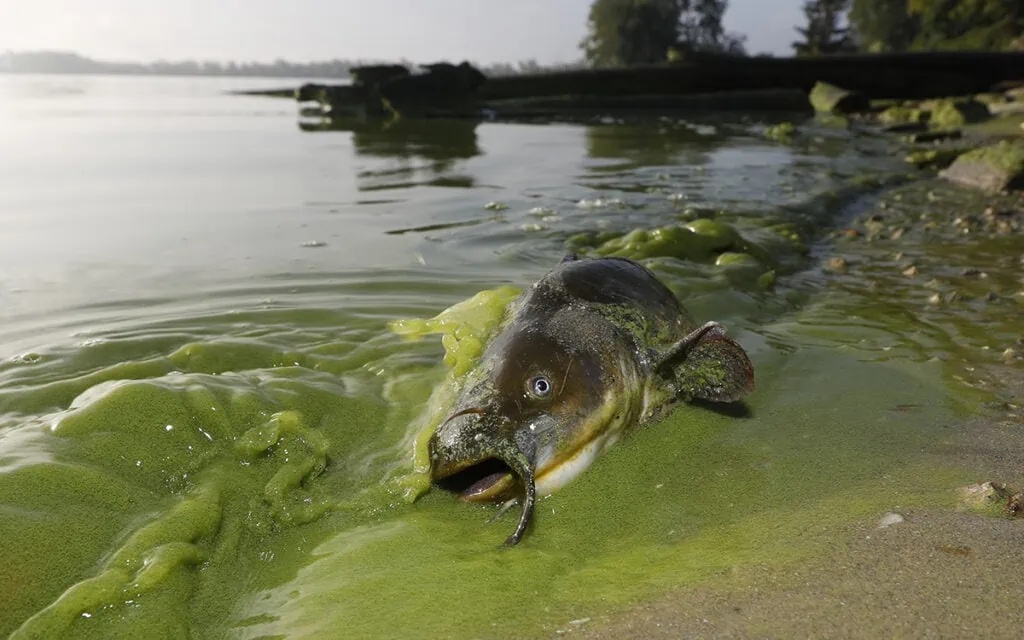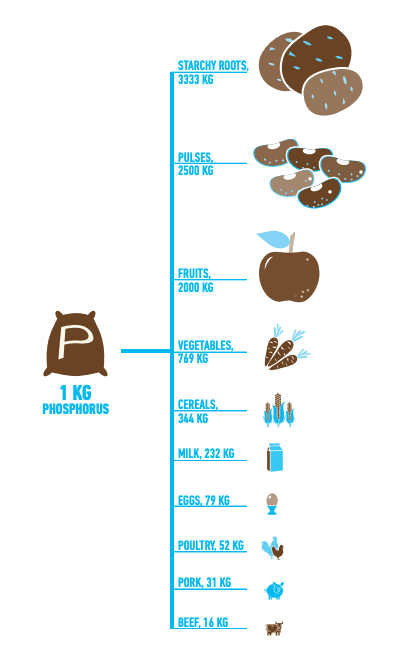The phosphorous problem, and the seaweed solution
There is a growing crisis at the base of the global food supply chain. The mismanagement of the world’s phosphorous supply is putting us at risk of food shortages in a few short decades. In 2019, 500 scientists signed The Helsinki Declaration – an open letter to policymakers around the world calling for urgent progress towards sustainable phosphorous management. Considering its seriousness, headlines about this issue are relatively scarce, and many don’t understand the big picture, or what they can do to help. This article offers an overview of the ecological problem scientists are nicknaming ‘Phosphogeddon’, the role that seaweed plays in this crisis, and what we can do as individuals to help the situation.
What is phosphorous?
Phosphorous is an element which is primarily used in agriculture and food production. It’s a soil fortifier that encourages plant growth, winter hardiness, seed formation and water use efficiency. Found naturally in all plants, it is essential for growing plants, and biologists say that humanity could only produce half the food it currently does without phosphate and nitrogen (though the latter is essentially limitless as it makes up almost 80% of the atmosphere). Science fiction writer and luminary Isaac Asimov once said: “Life can multiply until all the phosphorus is gone and then there is an inexorable halt which nothing can prevent.”
The problem with phosphorous
Significant phosphorous deposits are only found in certain countries: Morocco and western Sahara have the most, followed by China, then Algeria. The vast majority of these are mined to create phosphate fertiliser, about fifty million tons of which are sold around the world each year. But phosphorous – like fossil fuel – is a finite resource. Commercial agriculture cannot rely on it forever; it must adapt to meet the reality of a dwindling supply, as well as a growing demand for food.
The other major problem with phosphate fertiliser is runoff. As with terrestrial plants, phosphate fertiliser encourages the rapid growth of aquatic plants. The uncontrolled runoff from commercial farms and gardens (as well as untreated sewage and leaking septic tanks) is causing giant algae blooms in our rivers, lakes and oceans.

These clouds of micro-algae – not to be confused with seaweed – feed on the nutrients washed into the waterways and grow out of control, creating huge canopies on the surface of the water, through which little sunlight can pass. This causes a reduction in oxygen levels in the water, leading to the collapse of the local food chain; a process called eutrophication. What’s more, when these algae blooms die, they release methane gas into the atmosphere, which in global warming terms is eighty times more potent than carbon dioxide.
Some of the world’s biggest bodies of freshwater are now afflicted, including Russia’s Lake Baikal, Lake Victoria in Africa and North America’s Lake Erie. Blooms at Erie have led to poisoning of local drinking water in recent years. “Just as they do on land, phosphates help aquatic plants to grow, and that is now having calamitous consequences in rivers, lakes and seas.” Choked by blooms, many of these bodies of water have become dead zones, where few creatures survive and which are expanding. One dead zone now forms in the Gulf of Mexico every summer, for example.
https://www.theguardian.com/environment/2023/mar/12/scientists-warn-of-phosphogeddon-fertiliser-shortages-loom
Climate change also compounds the issue of algal blooms – the warmer temperatures further encourage the rapid growth of micro-algae, causing more blooms per unit of phosphate pollution as a result.
Our phosphorous future
The largest study to date on this subject recommends a 50:50:50 goal: 50% less phosphate pollution and 50% more phosphate recycling by 2050. More than half of the phosphorous mined each year is lost as waste, either through fertiliser runoff, or human consumption and its resulting wastewater runoff. There is huge potential for recycling, and the technology must be prioritised in order to meet the 50:50:50 goal.
The OPF report is aimed at governments and policymakers – people who can effect change on a macro level. But there are things that we can do individually.
The role of seaweed
First, we must consider a diet with a smaller phosphorous footprint. In this diagram you can see that one kilogram of phosphorous produces just sixteen kilograms of beef, whereas the same amount of phosphorous could produce over three and a half tons of potatoes, two and a half tons of legumes, or two tons of fruit. We can use this information to make informed choices about our diets; reducing the amount of meat we eat and therefore our phosphorus footprints.
Seaweed is a crop that grows in saltwater, without the need for fertiliser. It’s full of protein and minerals commonly found in meat (like iodine) and has a savoury, umami flavour which makes it enjoyable to eat. It’s a food product that ticks a lot of boxes when looking for a healthy, tasty, environmentally-friendly alternative to meat.
Secondly, we must look for alternative, organic fertilisers like compost, animal manure, and of course – seaweed! Seaweed has been used as a fertiliser and soil improver for centuries, with evidence of its use going as far back as Rome and ancient Greece. The Norwegians named their seaweed for the livestock that ate it: grisetang and sauetang translate to ‘pig seaweed’ and ‘sheep seaweed’ respectively, and butare is derived from the Norwegian word for livestock – buskap.
Seaweed contains several useful plant nutrients, including nitrogen, potassium, magnesium and of course phosphate. The benefits of seaweed fertiliser include increased tolerance to environmental stressors (like fluctuations in temperature and soil pH), improved soil texture, better water retention, and a higher resistance to disease. Seaweed fertiliser can be applied in a number of different forms, including refined liquid extracts and dry powders.
The development of seaweed fertiliser and regenerative aquaculture has a significant role in the nutrient cycling process – ensuring the healthy movement of trace elements like carbon, nitrogen and phosphorous through the Earth’s environmental systems. It also provides a source of nutrition to humans – directly, via consumption, and indirectly, as an effective organic fertiliser and nutritious animal feed. The presence of properly managed seaweed in our waterways acts as a natural filtration system, improving the water quality overall. The seaweed fertiliser industry is still in its infancy, and so it holds significant potential for sustainable economic development as well as the environmental benefits already discussed.

Conclusion
The phosphorous problem is complex, with many environmental and socio-political factors to consider when seeking a solution. However, it’s quite clear that urgent action must be taken, and that seaweed can play a huge role on both ends of the supply chain. It can help individuals reduce their phosphorous footprints by providing a protein- and umami-rich alternative to meat, and provide an effective, organic alternative to phosphate fertilisers in the new commercial farming landscape to which we must adapt.